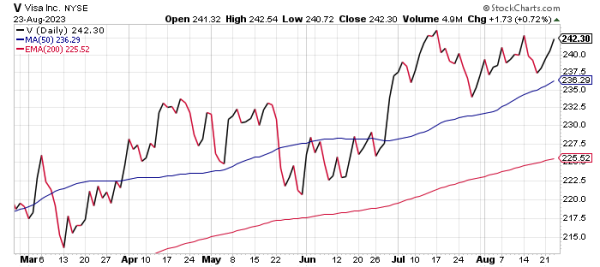The concept of economic moats is the primary theme of a great book by Pat Dorsey called “The Little Book that Builds Wealth.” Dorsey defines an economic moat as a durable competitive advantage that allows a firm to earn above-average returns on capital over a long period of time. I like a company that has a moat AND a quasi-monopoly on payment communications and credit card transactions: Visa (V), explains Carl Delfeld, editor of Cabot Explorer.
Since investing in a share of a stock is buying a small piece of a business, successful investing involves picking companies with built-in advantages giving them above average profits for as long as possible. This is important because in a free-market economy, like a hungry tiger, capital hunts for the areas of highest return.
Whenever a company develops a profitable product or service, it doesn’t take long before competitive forces drive down its economic profits. Only companies with an economic moat can hold competitors at bay and generate economic profits over an extended period.
An easy way to get some “moat stocks” into your portfolio is with the VanEck Morningstar Wide Moat ETF (MOAT), introduced early last year. MOAT is a basket of 20 moat stocks trading at relatively low valuations according to a Morningstar model. It was recently up 19% this year.
Visa is a single-stock alternative. It doesn’t extend credit but it provides the plumbing for financial payments and communications throughout the world. It has the largest card network in the US, processing $14.5 trillion of payment volume in the last 12 months. Visa’s financial infrastructure also underpins much of the world’s commerce.
The company had another stellar showing during its recent quarter, reporting $8.1 billion in revenues, up 12% ear-over-year, compared to $7.3 billion a year ago. It also posted a profit of $4.5 billion, or $2.16 per share, against $4.2 billion, or $1.98, the year before. Resilient and resurgent global travel and trade, coupled with healthy consumer spending, helped the company beat expectations at the top and bottom lines.
During the quarter, Visa processed a total of 54 billion transactions across the world, up 10% and worth over $3.2 trillion, an increase of 8%. The total cards issued now stand at 4.2 billion, up 7%, compared to 3.9 billion, divided between credit and debit cards. The recovery in global travel resulted in an impressive 17% growth in cross-border payments.

The duopoly between Visa and Mastercard is often referred to as one of the best businesses in the world, with insurmountable moats, low operating costs, and plenty of opportunities for unlocking additional value. Visa currently trades at a 21% discount to its arch-rival Mastercard. This leaves it much better poised to outperform the latter going forward.
Recommended Action: Buy V.

















